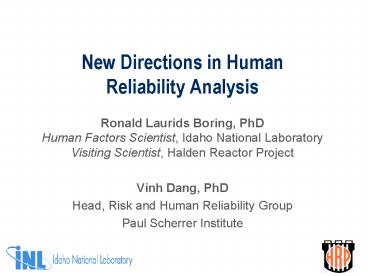New Directions in Human Reliability Analysis PowerPoint PPT Presentation
1 / 13
Title: New Directions in Human Reliability Analysis
1
New Directions in Human Reliability Analysis
- Ronald Laurids Boring, PhDHuman Factors
Scientist, Idaho National LaboratoryVisiting
Scientist, Halden Reactor Project - Vinh Dang, PhD
- Head, Risk and Human Reliability Group
- Paul Scherrer Institute
2
Human Reliability Analysis (HRA)
- Reminder Definition of HRA
- The use of systems engineering and human factors
methods in order to render a description of the
human contribution to risk and to identify ways
to reduce that risk - Typically considered to have from two to four
phases
3
Whats New in HRA?
- Emphasis on data scrutability
- Use of simulation and modeling
- Use of dynamic HRA
- Emphasis on HRA for design
4
Data Scrutability
- Earlier HRA methods have not always been
carefully validated - The PSF multipliers and overall quantification
may not have drawn heavily on human performance
data sources - A two-pronged problem
- Disconnect between human factors and HRA, such
that most empirical results from human factors do
not readily map to HRA - Both are interested in probabilities Human
factors reports significance levels (p lt .05),
but not always the size of the performance
enhancement or degradation (?HEP) - Many HRA methods draw heavily on expert
estimation to determine either the PSF
multipliers or the overall HEP - A normative model of risk should not be based on
somebodys best guess!
5
Use of Simulation and Modeling
- Put the virtual back in reality!
- Simulators real humans virtual environments
- Simulation virtual humans virtual
environments - Human performance testing/determination of HEPs
6
Use of Dynamic HRA
- Dynamic PRA/PSA has been discussed for years
- Attempt to model how risk and safety change over
time and contexts - One PRA/PSA model fits all cases fails to account
for emerging situations or even unanticipated
situations - Dynamic HRA has also been suggested
- Need to account for the dynamic progression of
human behavior leading up to and following an
event, accident, or incident - Need to capture the dynamic decisions that can
dramatically change the course of an event
7
Emphasis on HRA for Design
- Increasingly, human reliability needs to go
beyond being a diagnostic tool to become a
prescriptive tool - US NRC and nuclear industry are looking at new
designs for control rooms and want plants
designed with human reliability in mind, not
simply verified after the design is completed - NASA has issued strict Human-Rating Requirements
(NPR 8705.2) that all space systems designed to
come in contact with humans must demonstrate that
they impose minimal risk, they are safe for
humans, and they maximize human reliability in
the operation of that system - How do we make reliable human systems?
- Design
- Test
- Model
classic human factors
human reliability analysis
8
Human Reliability Design Triptych
9
Three Generations of HRA?
10
Counter Arguments
- Do you really mean to argue that cognitive
modeling can get us HRA? - Cognitive modeling has clear limitations
- But, it is getting to the point where it can
realistically model human decision making - Also proving successful at modeling PSFs
- E.g., work by INL to map VACP to SPAR-H
MicroSaint modeling of SPAR-H - Important to baseline virtual performance to
actual human performance - Marriage of simulators and simulation
- Cautious extrapolation to new domains
11
More Counter Arguments
- Does HRA really need to be dynamic?
- New directions in HRA like resilience engineering
are frustrated with the static nature of HRA/PRA
models, which do not account for the full
spectrum of human performance - Trying to model human performance in a simulator
or simulation reveals that current HRA models do
not account for - Evolving nature of PSFs (e.g., fatigue increases
over time) - PSF latency (e.g., stress does not instantly
disappear just because a stressful event
disappears) - Complex dependencies between concurrent, parallel
activities
12
Final Counter Arguments
- Do we need new generations of HRA?
- It offers some clear advantages
- Better understanding of the data behind human
performance - Ability to answer new questions
- Predict performance in novel domains
- Answer design questions using HRA as a human
factors tool - Create richer models for reconstructions of past
events
13
The End, My Friend
- New HRA does not render other HRA obsolete
- Widely used first generation methods like THERP
are still useful tools with a solid data basis - Second generation methods offer good insights on
PSFs and quantification - Should continue to be developed
- Trickle up effect to third generation HRA
- New HRA is a framework that
- Improves HRA data quality
- Improves predictive ability (and applications) of
HRA - Needs facilities like HAMMLAB simulator studies
to provide data

